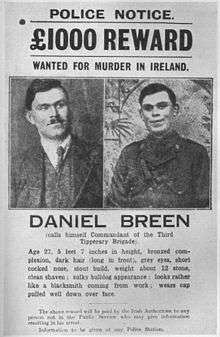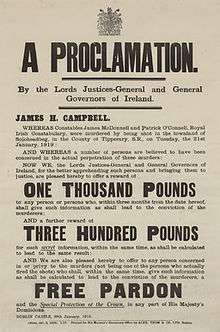Soloheadbeg ambush
The Soloheadbeg ambush took place on 21 January 1919, when members of the Irish Volunteers (or Irish Republican Army, IRA) ambushed Royal Irish Constabulary (RIC) officers who were escorting a consignment of gelignite explosives at Soloheadbeg, County Tipperary. Two RIC officers were killed and their weapons and the explosives were seized. As it happened on the same day that the revolutionary Irish parliament declared Ireland's independence, it is often seen as the first engagement of the Irish War of Independence.[1] The volunteers acted on their own initiative and had not sought authorisation for their action.
Background and planning
In the Irish general election of December 1918, the Irish republican party Sinn Féin won a landslide victory, gaining 73 out of 105 seats (25 of these unopposed) in the British Parliament. However, in its election manifesto, the party had vowed to set up a separate government in Ireland rather than sit in the British Parliament. At a meeting in Dublin on 21 January 1919, Sinn Féin established an independent parliament called Dáil Éireann and declared independence from the United Kingdom of Great Britain and Ireland.
On that same day, an ambush would be carried out by Irish Volunteers from the 3rd Tipperary Brigade. It involved Seán Treacy, Dan Breen, Seán Hogan, Séamus Robinson, Tadhg Crowe, Patrick McCormack, Patrick O'Dwyer, Michael Ryan and Seán O'Meara (the latter two being cycle scouts). Robinson (who had participated in the Easter Rising) was the commander of the group that carried out the attack and Treacy (a member of the Irish Republican Brotherhood since 1911) coordinated the planning of the attack.[2] The unit involved acted on its own initiative.
The planning for the ambush took place in the 'Tin Hut' on a dairy farm in Greenane. Treacy, Breen and Hogan had been undertaking experiments with explosives there and considering ways to attack the RIC. Treacy was keen to begin hostilities with British forces and believed a military confrontation with the RIC and the British Army was the only way to establish the Irish Republic proclaimed in 1916 and voted for in 1918.
In December 1918, they received information that there were plans to move a consignment of gelignite from Tipperary British Army barracks to Soloheadbeg quarry. They began plans to intercept the consignment and Dan Breen's brother Lars, who worked at the quarry, received information that the consignment was to be moved around 16 January 1919. They anticipated that there would be between two and six armed escorts, and they discussed different contingencies such as where they would guard the RIC if they surrendered and decided that they would fire on the escort if it did not immediately surrender.[3]
Robinson, who had returned to the Brigade area after his release from jail, was briefed by Treacy about the plans to seize the gelignite. Robinson supported the plan and confirmed with Treacy that they would not request permission from the Irish Volunteer leadership. If they did, they would have to wait for a response, and even if the response was affirmative, it might not come until after the gelignite was moved.[4]
Ambush
Each day from 16 to 21 January, the men chosen for the ambush took up their positions from early in the morning to late afternoon and then spent the night at the 'Tin Hut'. On 21 January, around noon, Patrick O'Dwyer saw the transport leaving the barracks. The consignment was on a horse-drawn cart, led by two council men and guarded by two RIC officers armed with rifles. O'Dwyer cycled quickly to where the ambush party was waiting and informed them.[2] Robinson and O'Dwyer hid about 30 metres in front of the main ambush party of six, in case they rushed through the main ambush position.
After the transport reached the position where the main ambush party was hiding, masked volunteers appeared in front of them with their guns drawn and called on them to surrender. The two officers took up firing positions and the volunteers immediately fired upon them. Both RIC officers, James McDonnell and Patrick O'Connell, who were killed were native Roman Catholics.[3][5] As planned, Hogan, Breen and Treacy took the horse and cart with the explosives and sped off. They hid the explosives in a field in Greenane and threw a few sticks out on the roadside a few miles further on as a decoy. The explosives were moved several times and later divided up between the battalions of the brigade.[6] Tadhg Crowe and Patrick O'Dwyer took the guns and ammunition from the dead officers, while Robinson, McCormack and Ryan guarded the two council workers, James Godfrey and Patrick Flynn, before releasing them once the gelignite was far enough away.[3]
Breen gave apparently conflicting accounts of their intentions that day. One account implies that the purpose of the confrontation was merely to capture explosives and detonators being escorted to a nearby quarry.[7] The other was that the group intended killing the police escort to provoke a military response.
"Treacy had stated to me that the only way of starting a war was to kill someone, and we wanted to start a war, so we intended to kill some of the police whom we looked upon as the foremost and most important branch of the enemy forces.... The only regret that we had following the ambush was that there were only two policemen in it, instead of the six we had expected."[8]
Aftermath

The ambush would later be seen as the beginning of the Irish War of Independence, and it is claimed the men acted on their own initiative to try to start a war.[9][10][11][12] The British government declared South Tipperary a Special Military Area under the Defence of the Realm Act two days later.[13][14]
A meeting of the Executive of the Irish Volunteers took place shortly thereafter. On 31 January, An t-Óglach (the official publication of the Irish Volunteers) stated that the formation of Dáil Éireann "justifies Irish Volunteers in treating the armed forces of the enemy – whether soldiers or policemen – exactly as a National Army would treat the members of an invading army".[15]
There was strong condemnation from Catholic churchmen, as both of the dead were their parishioners. Arthur, Canon Ryan, of Tipperary declared them to be "martyrs to duty", and the "Curse of Cain" was upon the parish.
Commemoration
A monument was erected at the site of the ambush, and each year, a ceremony of remembrance is held there.
Footnotes and references
- ↑ English, Richard (1998), Ernie O'Malley: IRA Intellectual, Oxford: Oxford University Press
- 1 2 Aengus O Snodaigh (21 January 1999)'. "Gearing up for war: Soloheadbeg 1919
- 1 2 3 Irish Bureau of Military History, Witness Statement 1432 Patrick O'Dwyer
- ↑ Irish Bureau of Military History, Witness Statement 1721, Seamus Robinson
- ↑ "The Soloheadbeg Ambush - 21 January, 1919". Garda Síochána Historical Society. Retrieved 15 September 2018.
- ↑ Irish Bureau of Military History, Witness Statement 1450, John Ryan
- ↑ Peter Berresford Ellis (2007). Eyewitness to Irish History. John Wiley & Sons. pp. 231–232. ISBN 978-0-470-05312-6.
- ↑ History Ireland, May 2007, p.56.
- ↑ Irish Freedom by Richard English ( ISBN 978-0-330-42759-3), page 287
- ↑ The Irish War of Independence by Michael Hopkinson ( ISBN 978-0773528406), page 115
- ↑ A Military History of Ireland by Thomas Bartlett and Keith Jeffery ( ISBN 978-0521629898), page 407
- ↑ Michael Collins: A Life by James Mackay ( ISBN 1-85158-857-4), page 106
- ↑ Sean Treacy and the 3rd. Tipperary Brigade by Desmond Ryan (Tralee 1945), p.74
- ↑ Police Casualties in Ireland, 1919-1922 by Richard Abbott ( ISBN 978-1856353144), p.49
- ↑ "Archived copy". Archived from the original on 2012-03-05. Retrieved 2010-07-10.
Bibliography
- Abbot, R “Police Casualties in Ireland (1919-1922)” p. 30–32 ( ISBN 1856353141)
- Aengus O Snodaigh (21 January 1999). "Gearing up for war: Soloheadbeg 1919". An Phoblacht.

